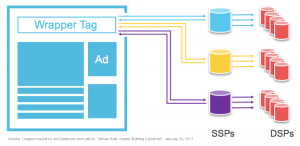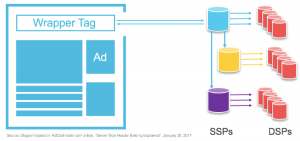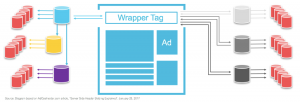On Wednesday, August 30, we hosted a live Twitter chat with PubMatic experts Jeff Hirsch and Nishant Khatri to discuss header bidding wrapper solutions.
Wrapper solutions fall under three different types: client-side, server-side and hybrid solutions. What do each of those mean and what does that mean for publishers? Check out our transcript from the conversation to “unwrap” wrappers.
Question 1: First things first. What is a client-side wrapper?
Jeff: Header bidding wrappers, generally speaking, take demand from multiple SSPs and aggregate it all into one bid. Client-side wrappers means it sits in the browser.

Nishant: A client-side wrapper is a JavaScript tag on the user’s page that makes asynchronous calls to each demand source from the browser. The benefits for client-side include increased yield and transparency/control. However, integrating multiple demand partners can cause latency issues.
Question 2: Conversely, what is a server-side wrapper?
Jeff: Though still a tag on the page, server-side wrappers make one call to the SSP that provides the wrapper infrastructure. From there, that primary SSP calls other SSPs. A server-side wrapper reduces latency and the impact on the user.

Nishant: A server-side wrapper allows a single SSP to send out an ad call to more demand partners without hurting latency. While this can result in higher eCPMs for the publisher, there is reduced transparency into the auction dynamics.
Question 3: What is a hybrid approach to wrappers?
Jeff: In a hybrid wrapper, the backend controls let publishers toggle between client- and server-side integrations via one tag on the page. This hybrid header bidding approach really plays to the strengths of each integration type and gives publishers more control.

Nishant: Client-side adapters can stay on the page with multiple calls sent out; server-side wrappers are moved to a primary SSP infrastructure. This way, publishers don’t risk client-side monetization while moving available partners to server-side setups in the future.
Question 4: How do wrappers help latency concerns with page load times?
Jeff: Wrappers help with latency because ad calls are made at the same time which creates more efficiency. While client-side wrappers reduce latency, multiple calls are still going out from the browser which slows load time.
Nishant: Wrappers reduce latency since browsers aren’t having to queue up calls; rather multiple calls are made asynchronously. Server-side wrappers decrease latency with a single call but many SSPs haven’t adopted this yet. Thus, the hybrid approach helps mitigate in the meantime.
Question 5: What are the core differences between a proprietary and open source wrapper solution?
Jeff: Proprietary wrappers rely on internal teams to maintain and optimize each adapter within the solution. Open source relies on developers to innovate for the good of industry; also, adapters are maintained by their respective exchanges.
Nishant: Proprietary wrappers are built and managed by an internal engineering team at an SSP. They are often fully supported but lack integrations and interoperability. Open source wrappers leverage a large community of developers but require account management and analytics support.
Question 6: Scalability seems to be an issue with proprietary wrappers. Why do these solutions struggle to scale?
Jeff: It is resource-related. Realistically, proprietary solutions can typically only support up to 10 to 15 demand adapters. Internal resources become strained with continually optimizing yield and reducing latency across all adapters. A bridge is needed to get the benefits of both proprietary and open source solutions.
Nishant: Since only internal engineers have access to the code, they have to integrate, update and maintain all 3rd party adapters. This means they can’t benefit from the development of their open source counterparts. There is also a risk to the publisher’s independence if a proprietary solution can’t scale. This is a problem because dependence on proprietary solutions could leave publishers underserved if an ad tech partner shifts strategy.
As a publisher, the most important aspects to look for in a wrapper solution are a solid UI, fast integration, lots of support, quality reporting, PMP support and demand integrations.
To learn more about hybrid wrapper solutions check out our latest case study and our own hybrid OpenWrap solution. Ready to take the next step and you are attending dmexco? Make sure to schedule time to meet with our team.



